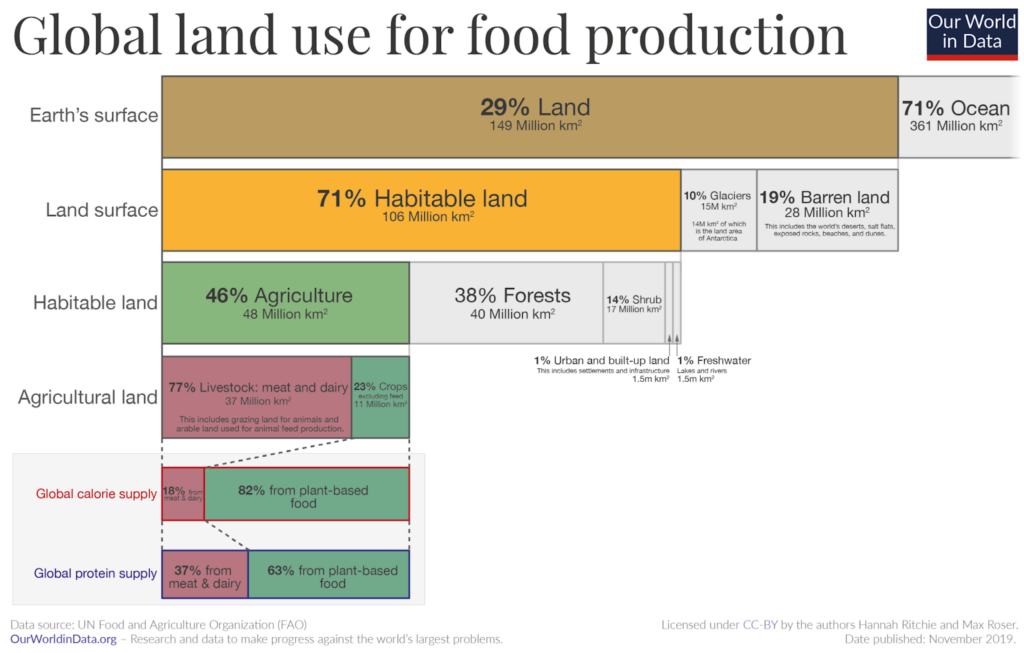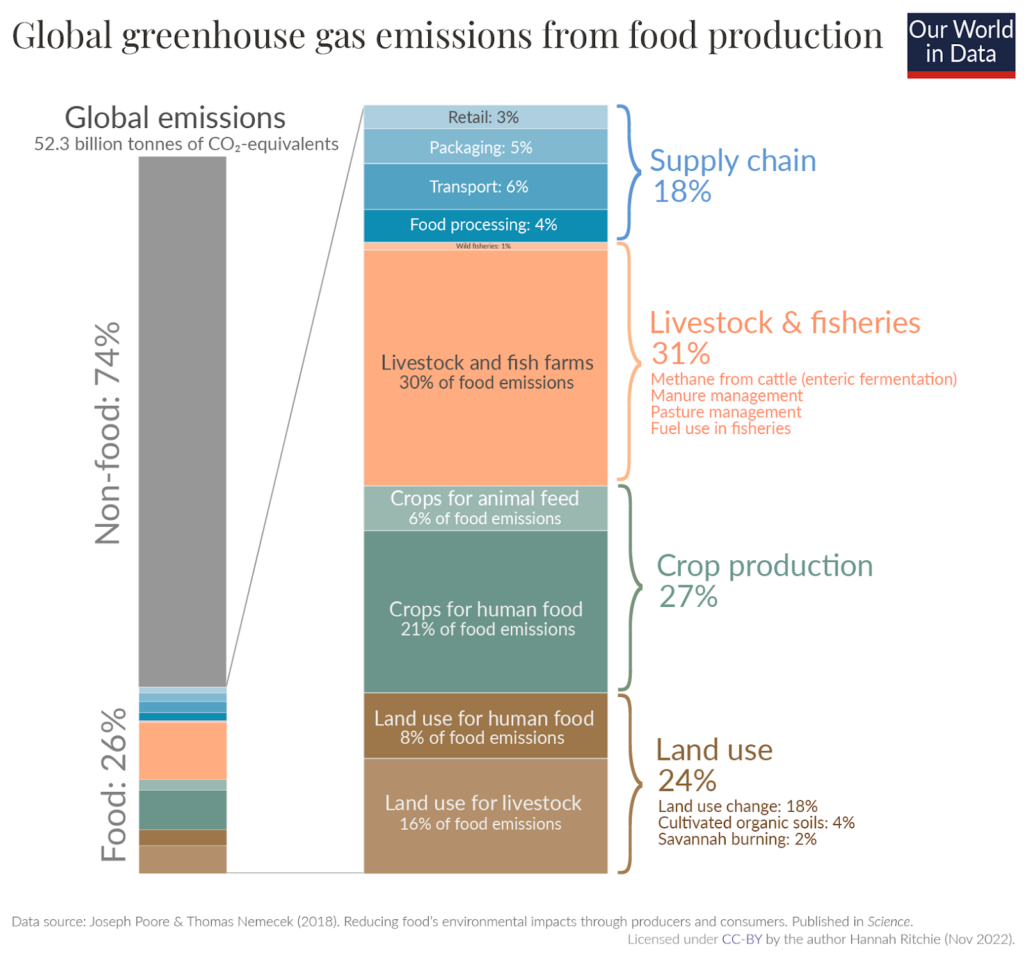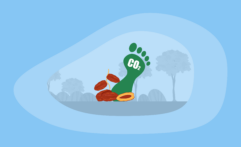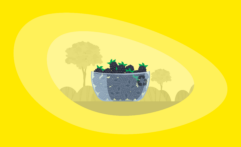Is Eating Watermelons Ethical & Sustainable? Here Are the Facts
Affiliate Disclosure
Hey fellow impactful ninja ?
You may have noticed that Impactful Ninja is all about providing helpful information to make a positive impact on the world and society. And that we love to link back to where we found all the information for each of our posts.
Most of these links are informational-based for you to check out their primary sources with one click.
But some of these links are so-called "affiliate links" to products that we recommend.
Why do we add these product links?
First and foremost, because we believe that they add value to you. For example, when we wrote a post about the environmental impact of long showers, we came across an EPA recommendation to use WaterSense showerheads. So we linked to where you can find them. Or, for many of our posts, we also link to our favorite books on that topic so that you can get a much more holistic overview than one single blog post could provide.
And when there is an affiliate program for these products, we sign up for it. For example, as Amazon Associates, we earn from qualifying purchases.
What do these affiliate links mean for you?
First, and most importantly, we still only recommend products that we believe add value for you.
When you buy something through one of our affiliate links, we may earn a small commission - but at no additional costs to you.
And when you buy something through a link that is not an affiliate link, we won’t receive any commission but we’ll still be happy to have helped you.
What do these affiliate links mean for us?
When we find products that we believe add value to you and the seller has an affiliate program, we sign up for it.
When you buy something through one of our affiliate links, we may earn a small commission (at no extra costs to you).
And at this point in time, all money is reinvested in sharing the most helpful content with you. This includes all operating costs for running this site and the content creation itself.
What does this mean for me personally?
You may have noticed by the way Impactful Ninja is operated that money is not the driving factor behind it. It is a passion project of mine and I love to share helpful information with you to make a positive impact on the world and society. However, it's a project in that I invest a lot of time and also quite some money.
Eventually, my dream is to one day turn this passion project into my full-time job and provide even more helpful information. But that's still a long time to go.
Stay impactful,
A summer picnic isn’t complete without some watermelon slices. They are a hydrating fruit, containing over 90% water, as well as protein and fiber. Watermelons are a quintessential American crop, as one of the top three agricultural products produced in the country. But watermelons can also participate in some unethical and unsustainable practices. So, we had to ask: Is eating watermelon ethical and sustainable?
Eating watermelons is fairly unethical. They have been linked to several unethical labor practices in the US, including wage theft, forced labor, and worker exploitation. Watermelons have also been linked to child labor in Mexico and Honduras.
Eating watermelons is fairly unsustainable. The watermelon industry has contributed to serious environmental damages such as desertification, pesticide pollution, and fertilizer pollution. However, they still maintain a low carbon footprint and avoid plastic packaging.
In this article, we will assess both the ethical and sustainability practices of the watermelons industry. Through these two lenses, you will be able to gain in-depth knowledge of the overall impacts of the watermelons that you eat!
Here’s How We Assessed the Ethics & Sustainability of Watermelons
The Sustainability Assessment of Food and Agriculture Systems (SAFA) is one of the ways we measure the externalities of our actions, like the consumption of watermelons. It is a holistic assessment based on the potential impact of food and agriculture operations on the environment and people. Those impacts are changes in our environment that can have adverse effects on the air, land, water, fish, and wildlife or the inhabitants of the ecosystem.
“Ethical: The discipline concerned with what is morally good and bad and morally right and wrong”
Encyclopedia Britannica
Ethics and sustainability are closely interconnected concepts that share a common objective: the well-being and preservation of our planet, including all its life and future generations.
“Sustainable: The ability to be maintained at a certain rate or level | Avoidance of the depletion of natural resources in order to maintain an ecological balance”
Oxford Dictionary
Basically, all goods and services you buy—including watermelons—leave an impact on people, animals, and our environment. And when it comes to food in general—and watermelons in specific—the following are key factors for their ethics and sustainability:
- Social and economic conditions: The ethics of food crucially depends on the social and economic conditions of the farmers who grow them. Especially on fair labor practices, including fair wages and safe working conditions.
- Seasonality: Eating seasonally is a lever of sustainability. The two key reasons are that seasonal food is more likely grown in their “natural growing season” without using greenhouses, and also more likely to be grown locally.
- Land requirements: Large parts of the world that were once covered by forests and wildlands are now used for agriculture. 10 million hectares of forest are destroyed annually and 50% of the world’s habitable land is now used for agriculture. This loss of natural habitat has been the main driver for reducing the world’s biodiversity.
- Water footprint: 70% of global freshwater is now used for agricultural purposes. By assessing the water footprint of a particular food, we can determine how our limited freshwater resources are being consumed and polluted.
- Pesticide and fertilizer usage: Pesticides and fertilizers provide a range of agricultural benefits. However, numerous studies link pesticides and fertilizers to serious effects on human health, along with disruptions to vital ecosystems and the spread of aquatic dead zones.
- Carbon footprint: The carbon footprint is one of the ways we measure the effects of our human-induced global climate change. Today, food production accounts for over a quarter (26%) of global greenhouse gas emissions.
- Waste generation: Food and its packaging account for almost 45% of the materials landfilled in the US alone. And packaging sent to landfills, especially when made from plastics, does not degrade quickly or, in some cases, at all.
To understand the overall environmental impact of watermelons, we must assess each of their key factors. This Sustainability Assessment of Food and Agriculture Systems (SAFA) is a tool developed for assessing the impact of food and agriculture operations on the environment and people. And this tool helps us to evaluate whether eating watermelons is ethical & sustainable.
Here’s How Ethical & Sustainable Eating Watermelons Is
The overall ethics & sustainability of watermelons is very low. The main factors that contribute to this are their associations with forced labor, wage theft, deforestation, pesticide pollution, and the use of harmful nitrogen fertilizers.
Watermelons do have some sustainable qualities. For example, they have a very low carbon footprint and they don’t use plastic packaging. However, there are still many other aspects of their production that are unethical and unsustainable.
So, let’s have a look at the ethics & sustainability impact of each key factor of watermelons!
| Key Assessment Factors | Ethics & Sustainability |
| Social and economic conditions of watermelons | Watermelons’ social and economic conditions are very bad. The watermelon industry engages in forced labor, as well as wage theft and exploitation of migrant workers in the US. |
| Seasonality of watermelons | Watermelons’ seasonality is from May to September. During the other months, they are typically imported from South America, meaning that they are fairly unsustainable for most of the year. |
| Land requirements for watermelons | Watermelons’ land requirements are very high. This, mixed with their tendency to be farmed in monocultures means they are very unsustainable at this stage. |
| Water footprint of watermelons | Watermelons have a high water footprint of 50–100 inches of water per year. Because of where they grow, they require a very high amount of irrigation, which is very unsustainable. |
| Agrochemical usage for watermelons | The pesticide and fertilizer usage of watermelon is very high. The particular fertilizers they use are also harmful to soil and local wildlife, and thus are very unsustainable. |
| Carbon footprint of watermelons | Watermelons have a low carbon footprint of 0.05kg (0.11 lb) of CO2e per pound of watermelon. They are produced domestically in the US and have a minimal harvesting, processing, and packaging footprint; despite their high pesticide usage and low composting rates. |
| Waste generation of watermelons | Watermelons’ waste generation is moderate. They use cardboard, which is easy to recycle, but have low composting rates for their food waste. |
These are the overall summaries, but there is a lot more to the story. In the next few sections, we will dive deeper into each stage to illustrate to you all the important aspects of watermelons’ ethics & sustainability.
How Ethical & Sustainable Are the Social and Economic Conditions for Watermelons
Watermelons’ social and economic conditions are very bad. The watermelon industry engages in forced labor, as well as wage theft and exploitation of migrant workers in the US.
Everything we consume was made or harvested by somebody. In past centuries, this was often someone who lived in your community and who you might have even known personally. But through the rise of globalized distribution systems, we have become increasingly alienated from the people who make our food. This leaves a lot of room for exploitation and abuse, both of which are rampant in the food industry. Here, we will look at how the watermelons industry fares in relation to these ethical questions.
How ethical & sustainable are the social and economic conditions of growing watermelons?
- Are farmers paid fair wages to grow watermelons: In theory, American watermelon pickers are supposed to earn the minimum wage. However, in practice, this is often not the case. There have been numerous accusations and lawsuits against the watermelon industry in the US for failing to pay adequate wages, despite workers putting in long hours. These reports are indicative of a pattern of wage theft among US watermelon farms, meaning that the watermelons you eat may very well have been grown by those not making a fair wage.
- How safe are the working conditions to grow watermelons: There are several ergonomic issues that watermelon pickers deal with, mainly because watermelons grow on the ground. Watermelons also use a high amount of pesticides, which means that workers are exposed to these chemicals, which can be very damaging to their health.
- Are there reports of child or forced labor to grow watermelons: There have not been widespread accounts of child labor in the watermelon industry. However, there have been some reports of child labor in the melon industry in general, particularly in Honduras, Mexico, Panama, and Paraguay. There have also been reports of forced labor in the US watermelon industry, particularly with migrant workers.
- What is the wider economic impact on the communities that grow watermelons: Migrant workers, who form a considerable amount of the US and Canada’s watermelon industry’s workforce, face many socio economic issues. These issues range from access to healthcare and housing, to police profiling.
In short, the watermelon industry has many ethical issues, such as forced labor, discrimination against migrant workers, and wage theft.
How Ethical & Sustainable Are the Seasonality for Watermelons
Watermelons’ seasonality is from May to September. During the other months, they are typically imported from South America, meaning that they are fairly unsustainable for most of the year.
Every fruit has a natural season in which they grow, usually lasting a couple of months, which can range depending on the region. However, international demand for every kind of fruit is year-round. This demand is often met by importing fruits from tropical places which can grow year-round, or by growing them in greenhouses. Both of these methods use more resources and are thus less sustainable than conventional farming. Here, we will look at how the watermelons industry accommodates year-round demand.
How ethical & sustainable is it to grow watermelons in-season vs out-of-season?
- When is the natural season for growing and harvesting watermelons: Watermelons are in season during the summer, from around May to September. This is a moderately sized season, but it still means that watermelons grown from October to April are usually imported.
- How are watermelons naturally grown in-season: Watermelons grow on the ground on vines. They take up to three months to mature. This is quick compared to many other fruits such as pineapples, which take around a year to mature. During the in-season, most watermelons are grown in the US. This means that in-season watermelons are considerably more sustainable than out-of-season watermelons.
- How are watermelons grown out-of-season: Out-of-season watermelons are typically imported from Mexico, Guatemala, and Honduras. This means that they are considerably less sustainable than in-season watermelons. The ethical conditions for workers in Mexico, Guatemala, and Honduras are also considered to be lower than those in the US.
In short, watermelons’ limited season for growth in the US means that they have to be imported for most of the year and thus are less sustainable during that time.
How Ethical & Sustainable Are the Land Requirements for Watermelons
Watermelons’ land requirements are very high. This, mixed with their tendency to be farmed in monocultures means they are very unsustainable at this stage.

The growth stage has a major impact on fruits’ sustainability. The amount of land used, especially in relation to its expansion, the method with which they are grown, and their effect on surrounding land and wildlife are all important factors. In this section, we will look at the ways in which watermelons’ land usage affects their sustainability.
How ethical & sustainable are the land requirements for growing watermelons?
- What is the land usage of watermelons: Watermelons have very high land usage, yielding only around 2–3 tons per hectare. This is an extremely low-density planting cycle compared to other fruits. For example, strawberries yield around 15–25 tons per hectare and bananas up to 100 tons per hectare. This low yield means that watermelons take up more space per pound than other fruits and thus require more land to farm.
- Where and how are watermelons grown: Worldwide, the majority of watermelons are grown in China, but most of the watermelons consumed in North America are usually produced in the US or Mexico. Watermelons grow on vines along the ground. Watermelons and other squash family foods don’t naturally sequester carbon like trees. However, efforts are being made to change this by introducing regenerative farming techniques. Many watermelons are grown in monocultures, which means that there are no other plants around. Monocultures lack biodiversity and thus are bad for wildlife and soil microbes.
- How does the growing of watermelons affect soil fertility and erosion: Watermelons have been found to contribute significantly to soil erosion. Soil erosion is very unsustainable and can permanently damage agricultural regions. For this reason, watermelon farming is very unsustainable at this stage.
- How does the watermelons industry affect the loss of habitable land: Watermelons grow in very low-density environments, which means that they need a lot of land to sustain them. Watermelons, in particular, contribute to an environmental phenomenon known as “desertification”. Desertification is the process by which agriculture depletes the soil of a region, turning it into a desert in just a few years. Watermelons, particularly in China, are notorious for desertifying large swaths of land.
- How does the watermelons industry affect wildlife and biodiversity: The process of desertification is not only harmful for future agriculture, but for local wildlife as well. It can be just as harmful as deforestation in terms of habitat loss. It also depletes food sources for local wildlife.
In short, the watermelon industry’s contribution to desertification, habitat loss, and soil erosion means their sustainability is very low in this category.
How Ethical & Sustainable Is the Water Footprint of Watermelons
Watermelons have a high water footprint of 50–100 inches of water per year. Because of where they grow, they require a very high amount of irrigation, which is very unsustainable.
Water usage is one of the most important factors in a fruit’s sustainability. Practices like irrigation use significant resources and can cause pollution, and as such, factors like the amount of water used, where it is sourced, as well as the way they affect the water sources around them, are all important. Here, we will look at these different angles of watermelons’ water footprint.
How ethical & sustainable is the water footprint of growing watermelons?
- What is the overall water usage of watermelons: Watermelons need around 50–100 inches of water per year. This is a very high water requirement compared to other fruits. For example, mangoes only need 26–52 inches per year.
- What is the green water footprint of watermelons: The green water footprint is the amount of water from precipitation stored in the soil and used by plants for growth. Watermelons are primarily grown in the southern US, mostly in Arizona and California. Arizona gets around 12 inches of rainfall per year and California gets around 23 inches per year. Therefore, all the rainfall in the area will be going to watermelon farms and so their green water footprint is very high.
- What is the blue water footprint of watermelons: The blue water footprint is the amount of water sourced from surface (such as rivers or lakes) or groundwater resources. Since the annual rainfalls of both Arizona and California are too low to meet watermelons’ water requirements, they will require significant irrigation. Irrigation is very unsustainable, due mainly to its high carbon footprint and modification of groundwater balance. Thus, their blue water footprint is very high.
- What is the gray water footprint of watermelons: The gray water footprint is the amount of freshwater required to clean up water pollution to meet certain quality standards. Essentially, it’s the amount of water needed to make polluted water clean enough to be safe and healthy for humans and the environment. Unfortunately, watermelons have been found to have very high pesticide use. Pesticides pollute the groundwater, meaning excess water is required to clean them up. Their high pesticide use means that a significant amount of water will be needed to compensate for watermelons’ groundwater damage. As a result, their gray water footprint is very high.
- How does the watermelons industry affect freshwater and ocean pollution: Watermelons use very high amounts of pesticides, as well as nitrogen fertilizer. Both nitrogen fertilizer and pesticides are very harmful to groundwater. Nitrogen fertilizer in particular causes invasive growth of algae which can wreak havoc on water systems and endanger marine life.
In short, the watermelon industry’s use of extensive irrigation, as well as high amounts of pesticides means their water sustainability is very low.
How Ethical & Sustainable Is the Agrochemical Usage for Watermelons
The pesticide and fertilizer usage for watermelon is very high. The particular fertilizers they use are also harmful to soil and local wildlife, and thus are very unsustainable.
Pesticides and fertilizers are agrochemicals that are very unsustainable and damaging to ecosystems. This is because they require resources to create and can easily run off into groundwater and soil systems. Here, we will look at how sustainable watermelons’ pesticide and fertilizer rates really are.
How ethical & sustainable is the agrochemical usage of growing watermelons?
- What is the pesticide usage of watermelons: Watermelons have high pesticide usage. Pesticides are very unsustainable because they pollute groundwater, have a high carbon footprint, and can even harm wildlife.
- What is the fertilizer usage of watermelons: Watermelons use mainly nitrogen fertilizer at the beginning of life, then phosphorus and potassium later on. Potassium is minimally polluting. However, nitrogen has been known to be a major pollutant. Watermelons’ use of fertilizer is thus very unsustainable.
- Are there any known issues connected to the agrochemical usage for watermelons: Watermelons’ use of nitrogen fertilizer has many issues associated with it. For one, it can cause air pollution which affects humans, animals and plants alike. Nitrogen fertilizer causes oxygen depletion and contributes to dead zones in water sources, particularly around the Gulf of Mexico and other vital habitats.
In short, watermelons’ extremely high pesticide usage, as well as their use of the harmful nitrogen fertilizer means that they are very unsustainable in the agrochemical department.
How Ethical & Sustainable Is the Carbon Footprint of Watermelons
Watermelons have a low carbon footprint of 0.05kg (0.11 lb) of CO2e per pound of watermelon. They are produced domestically in the US and have a minimal harvesting, processing, and packaging footprint; despite their high pesticide usage and low composting rates.

Carbon footprint is one aspect of the overall sustainability of a fruit. It essentially measures how much carbon or other greenhouse gasses the production of fruits emits into the atmosphere. Emissions from product manufacturing, irrigation, transportation fuel, and landfills all add up to create the overall carbon footprint of a fruit. Let’s see how the carbon footprint of watermelons contributes to their overall sustainability.
How ethical & sustainable is the carbon footprint of watermelons?
- What is the overall carbon footprint of watermelons: The overall carbon footprint of watermelons is very low at 0.05kg (0.11 lb) of CO2e per pound of watermelon. This means that for every pound of watermelons produced, 0.05kg of carbon is released into the atmosphere. This is one of the lowest carbon footprints among fruits.
- What are the main contributors to the carbon footprint of watermelons: The main factors that affect their carbon footprint are high pesticide use, low composting rates, low-density agriculture, and refrigeration during transportation.
- Which life-cycle stage of watermelons has the highest carbon footprint: The stage that contributes the most to watermelons’ carbon footprint is growth. This is because of their low-density planting and high pesticide use.
In short, watermelons have certain high-carbon components to their life cycle, but overall they have one of the lowest carbon footprints amongst fruits, meaning they are actually relatively sustainable when it comes to their carbon footprint.
How Ethical & Sustainable Is the Waste Generation of Watermelons
Watermelons’ waste generation is moderate. They use cardboard, which is easy to recycle, but have low composting rates for their food waste.
When fruit waste, either in the form of packaging or organic materials, is disposed of, it can cause a lot of problems. Whether it’s damaging wildlife, getting into oceans, emitting methane, or dissolving into microplastics that contaminate groundwater, all these materials have their part to play. The sheer amount of waste we produce is reaching a crisis point and won’t be able to continue much longer. In this section, we will look at how sustainable watermelons’ waste generation is.
How ethical & sustainable is the waste generation of watermelons?
- What is the packaging of watermelons: Watermelons typically use cardboard during the transportation stage. Cardboard is a fairly unsustainable material, mainly because of their contribution to deforestation.
- How is the packaging of watermelons disposed of: Cardboard recycling has a fairly high recycling rate of around 89%. However, this still means that some cardboard is ending up in landfills. Landfills are very unsustainable because they emit carbon, pollute the soil, and harm wildlife. So if even a small amount of cardboard is going into landfills, it is somewhat unsustainable. Saying that, cardboard is much more sustainable than less-recycled materials such as plastic and styrofoam.
- How are watermelons disposed of: Watermelons have rinds that can theoretically be composted. However, composting rates amongst food waste are very low, at around 4%. This means that the vast majority of watermelon waste is ending up in the landfills. On top of the general negative qualities of landfills, food waste is particularly bad, since it releases methane.
In short, watermelons’ waste is somewhat sustainable, since all their materials can theoretically be recycled or composted, even though their food waste is not widely composted in practice.
What Have Been Historical Ethics & Sustainability Issues Connected to the Watermelon Industry
Watermelons have partaken in some farming or labor practices that have harmed the environment a lot over the years. These include wage theft, deforestation, desertification, and use of contaminating fertilizers and pesticides.
All fruits have had a complex road toward global distribution. They originate in one part of the world and often travel far to end up in your local supermarket. From farm to table, some of our favorite fruits have used unsustainable practices. Whether it’s exploiting labor, deforestation to meet demand, water pollution, or disruption of wildlife, most fruits have left a path of destruction. Many of these effects are still felt today or have even increased. Let’s see how watermelons have fared throughout history.
What have been the key ethical & sustainable issues of the watermelons industry?
- Has labor been exploited because of watermelon production: Labor rights violations have been prevalent in the watermelon industry. Migrant workers in the Michigan watermelon industry were involved in a major wage theft lawsuit in 2013. They sued their employers over being paid less than the federal minimum wage and were granted a settlement of almost $15,000 in 2016. Labor disputes like this show that there is room for such exploitation in the US watermelon industry.
- How much land has been lost because of watermelon production: Watermelon production has used around 3 million hectares of land to date. This land usage represents not just deforestation, but also potential desertification as these watermelon farms deplete surrounding resources.
- Which wildlife species have been negatively impacted or displaced because of watermelon production: Much of the deforestation and desertification caused by watermelons has harmed wildlife. Many animals use these regions and resources as their habitats, which are lost when agriculture replaces them. Habitat loss is the number one cause of endangered species worldwide.
- Have water sources and soil been contaminated because of watermelon production: Watermelon production has caused severe droughts. In particular, Northern Morocco, which is a major watermelon-producing region, has seen significant droughts due to how much water watermelons consume. Their use of pesticides and nitrogen fertilizer has also harmed the environment over the years. The accumulation of nitrogen in soils has now become a significant component of its environmental impact.
In short, watermelons have caused some significant damage to people and the environment. Their violations of minimum wage laws, as well as their use of nitrogen fertilizer, and pesticides have all contributed to their history of unethical and unsustainable conduct.
How Can You Reduce Your Environmental Impact and Offset Your Personal Carbon Footprint
There are a few things you can do to make your watermelon consumption more ethical and sustainable, while still enjoying them. You can also consider offsetting your personal and watermelon-related carbon emissions, which work to remove carbon emissions elsewhere that are then attributed to you. Here, we will walk you through how to accomplish both of these things.
How Can You Shop for Watermelons More Ethically & Sustainably
In this section, we give you a short list of ways you can consume watermelons in a more sustainable way. This list is designed to target the most unsustainable parts of watermelons’ life-cycle:
- Buy watermelons in-season: Outside the months of May to September, watermelons are mainly imported from Mexico and Central America. When you make sure to buy them in-season, you are raising the likelihood that they are domestic watermelons considerably. Not only do domestic watermelons have shorter travel times, but also US watermelons do not have major reports of child labor like Mexico and Honduras. Therefore, making sure you buy domestic, in-season watermelons will help you be more ethical and sustainable in your watermelon consumption.
- Compost and recycle: Waste disposal and landfills are big negative contributors to watermelons’ sustainability problems. If you make sure that you recycle any packaging and compost any food waste, then you will be making your watermelon consumption considerably more sustainable.
- Buy organic watermelons: Watermelons’ high pesticide use is a major contributor to their ethical and sustainability issues, with pesticides being both damaging to the environment and dangerous for workers. Organic farms generally avoid high amounts of chemical pesticides and nitrogen fertilizers and so they are good to support if you want to reduce your pesticide and fertilizer impact.
Following some of these methods can really help you to make your watermelon-eating more sustainable. None of these will completely eradicate the negative impacts, since there are always effects that may be outside of your control. But some reduction is always better than nothing!
Which Organizations Can You Support to Help Promote Ethics & Sustainability
While watermelon production engages in some very unsustainable practices, there are also some organizations that help you change the parts of these processes that would otherwise be outside of your control. These organizations are working hard to prevent and reverse damage to the environment caused by industries like watermelon agriculture, towards a more sustainable future.
In the table below are some of the best charities that work in the areas where watermelon production are very unsustainable—and beyond:
Though it is helpful to boost the sustainability of your personal watermelon consumption, supporting these organizations takes your positive impact a step further. You will be reaching far beyond your own consumption impacts and helping to build a better world for everyone!
How Can You Offset Your Personal Carbon Footprint
The carbon footprint is a key part of how sustainable we live. And it is one of the ways we measure the effects of our human-induced global climate change. Yes, even from eating watermelons!
“Carbon footprint: the amount of greenhouse gasses and specifically carbon dioxide emitted by something (such as a person’s activities or a product’s manufacture and transport) during a given period”
Merriam Webster
Basically, it is the amount of carbon emitted by you as an individual or an organization providing you with goods and services – including watermelons:
- This includes GHG emissions from producing the products that we use and foods that we eat (e.g., power plants, factories or farms, and landfills)
- GHG emissions from fuel that we burn directly or indirectly (e.g., logistics and transportation, cooling or heating facilities),
- as well as the GHG emissions attributed to how we consume these products and foods.

Carbon offsets are reductions in carbon emissions that are used to compensate for carbon emissions occurring elsewhere – for example for the carbon emissions that are associated with watermelons. They are measured in tons of CO2 equivalents and are bought and sold through international brokers, online retailers, and trading platforms on what is known as the global carbon offset market.
“Carbon Offset: a way for a company or person to reduce the level of carbon dioxide for which they are responsible by paying money to a company that works to reduce the total amount produced in the world, for example by planting trees”
Oxford Dictionary
In terms of watermelons – and indeed all food types – there will always be a carbon footprint, because of the resources it takes to get your food from farms to the place where you’ll eventually eat them. And while there are ways to reduce your carbon footprint when shopping for watermelons, carbon offsets would be a way to reduce your CO2e emissions all the way down to net zero (or even to become climate positive).
However, when you purchase carbon offsets, it’s important that they actually make a difference in offsetting (aka reducing) total carbon emissions. To achieve that, the following are key criteria:
- Carbon offset projects have to be effective (different projects have different effectiveness rates)
- Carbon offset projects have to be additional
- Carbon offset projects have to be permanent
- The claims from carbon offset projects have to be verifiable
To find the best carbon offsets for you personally, check out our full guide on the best carbon offsets for individuals, where you’ll also learn more about how these carbon offset projects work, what their respective offsetting costs are, and what your best way would be to offset your own carbon emissions.
Final Thoughts
Watermelons engage in some seriously unethical and unsustainable practices. They have been linked to forced labor, wage theft, deforestation, and pesticide and fertilizer pollution. These practices are worrying, but the good news is that there are plenty of ways to be a more ethical and sustainable watermelon consumer. For example, if you buy watermelons in-season, responsibly dispose of packaging, and support charities that aim to make a difference in big environmental issues, you can have a more positive impact.
Stay impactful,

Sources
- What About Watermelon: 32 Fun Facts About Watermelon
- Healthline: Watermelon 101
- AGMRC: Watermelon
- Food and Agriculture Organization of the United Nations: SAFA (Sustainability Assessment of Food and Agriculture systems) Guidelines
- Food Ethics Council: What is food ethics?
- The Fair Labor Association: Agriculture Standards
- MDPI Sustainability: Eating in Season—A Lever of Sustainability? An Interview Study on the Social Perception of Seasonal Consumption
- MDPI Foods: The Role of Local Seasonal Foods in Enhancing Sustainable Food Consumption: A Systematic Literature Review
- UN Environment Programme: Environmental Impact Assessment and Strategic Environmental Assessment: Towards an Integrated Approach
- Our World in Data: The environmental impacts of food and agriculture
- Our World in Data: Global land use for food production
- World Health Organization: Preventing disease through healthy environments: a global assessment of the burden of disease from environmental risks
- ScienceDirect (Biological Conservation): Worldwide decline of the entomofauna: A review of its drivers
- EPA: The Sources and Solutions: Agriculture
- EPA: Reducing Food Waste and Packaging
- FoodPrint: The Environmental Impact of Food Packaging
- BHG: How to Grow Watermelon
- Impactful Ninja: What is the Carbon Footprint of Watermelons
- Our World in Data: Greenhouse Gas Emissions per 1,000 kilocalories
- NPR: In South Texas, Fair Wages Elude Farmworkers
- My Tips and Advice: Reducing the Risks to Seasonal Fruit Pickers
- Graphic: Unacceptable Levels of Pesticides in Our Watermelons
- Verite: Melons
- Business: USA Mexican Workers Contracted Subject to Forced Labor on Watermelon Farms
- The Guardian: Meet the Workers Who Put Food on America’s Tables
- CBC: Human Rights of Migrant Workers
- Food Network: In-Season Watermelon
- USDA: Imports Supply About a Third of US Watermelon Consumption
- BHG: How to Grow Watermelon
- Agriculture Review: Pineapple Farming Guide
- Watermelon: Year-Round Story
- Islamic Azad University: Energy-Use Pattern and Carbon Footprint of Rain-Fed Watermelon
- North Carolina State University: Yield Response of Watermelon to Planting Density
- Statistica: Strawberry Yield Scotland
- Impactful Ninja: What is the Carbon Footprint of Bananas
- World Atlas: Top Watermelon-Producing Countries in the World
- Gardeners Path: How to Plant and Grow Watermelons
- NPS: Carbon Storage by Urban Forests
- Labroots: Lowering the Carbon Footprint of Pumpkin Farming
- NCBI: Wheat Straw Increases the Defense Response of Watermelons
- EOS: Monoculture Farming Explained
- Science Direct: Alleviating Soil Degradation Caused by Watermelons
- WRI: Causes and Effects of Soil Erosion
- World Bank: China Fighting Desertification
- Iberdrola: What is Desertification?
- Impactful Ninja: What is the Carbon Footprint of Mangoes
- Peppers Home and Garden: How Much Water Do Mango Trees Need
- Water Footprint: What is a Water Footprint
- AZ Climate: Arizona
- OEHHA: California Climate
- Science Direct: Energy and Carbon Footprint of Irrigation
- World Atlas: Environmental Impact of Irrigation
- Graphic: Unacceptable Levels of Pesticides in Our Watermelon
- USGS: Pesticides in Groundwater
- EPA: Excess Nitrogen in the Atmosphere of Forests, Soils, and Waterways
- Pesticide.org: Pesticides and the Climate Crisis
- GOV.BC: Environmental Protection and Pesticides
- Yara: Best Fertilizers for Melons
- Plant Nutrition: Potassium
- Mitsui: Reducing the Environmental Impact of Chemical Fertilizer
- Impactful Ninja: What is the Carbon Footprint of Watermelons
- EPA: Reducing the Impact of Wasted Food
- USA Truckload Shipping: How Are Watermelons Transported
- ITF Net: Watermelon Post-Harvest Processing
- TRVST: Environmental Impact of Cardboard
- Also Known As: 12 Interesting Facts About Packaging Waste
- SL Recycling: What Are the Negative Effects of Landfill
- GOV.BC: Waste Management
- FAO: Watermelon
- WWF: Impact of Habitat Loss on Species
- Qantara: Water Shortage in the Maghreb
- United States Environmental Protection Agency (EPA): Climate Change Terms
- Impactful Ninja: Best Charities That Advance Ethics Worldwide
- Impactful Ninja: Best Charities That Promote Sustainability
- Impactful Ninja: Best Charities That Help Farmers
- Impactful Ninja: Best Charities That Fight to Protect our Environment
- Impactful Ninja: Best Charities for Reforestation
- Impactful Ninja: Best Wildlife Conservation Charities
- Impactful Ninja: Best Charities for Protecting the Amazon Rainforest
- Impactful Ninja: Best Charities That Fight for Clean Water
- Impactful Ninja: Best Charities That Help Conserve Our Rivers
- Impactful Ninja: Best Charities to Save Our Oceans
- Impactful Ninja: Best Charities for Helping Farm Animals
- Impactful Ninja: Best Charities for Climate Change
- Impactful Ninja: Best Carbon Offsets for Individuals
- Impactful Ninja: Best Charities That Fight to Reduce Food Waste
- Impactful Ninja: Best Charities That Fight to End Plastic Pollution
- Impactful Ninja: Best Charities That Promote Recycling
- Impactful Ninja: Why Is a Carbon Footprint Bad for the Environment?
- Impactful Ninja: Best Carbon Offsets for Individuals




